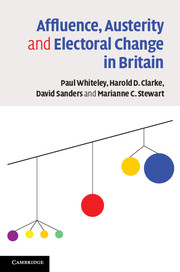Book contents
- Frontmatter
- Contents
- List of Figures
- List of Tables
- Acknowledgments
- 1 The politics of affluence and austerity
- 2 Tony's politics
- 3 Gordon's politics
- 4 ‘I agree with Nick’
- 5 Making political choices
- 6 Bearish Britain
- 7 Choosing how to choose
- 8 Performance politics and subjective well-being
- 9 Valence politics, austerity policies and electoral prospects
- Appendix A Design of the 2010 British election study
- Appendix B Measurement
- Notes
- Bibliography
- Index
Appendix A - Design of the 2010 British election study
Published online by Cambridge University Press: 05 June 2014
- Frontmatter
- Contents
- List of Figures
- List of Tables
- Acknowledgments
- 1 The politics of affluence and austerity
- 2 Tony's politics
- 3 Gordon's politics
- 4 ‘I agree with Nick’
- 5 Making political choices
- 6 Bearish Britain
- 7 Choosing how to choose
- 8 Performance politics and subjective well-being
- 9 Valence politics, austerity policies and electoral prospects
- Appendix A Design of the 2010 British election study
- Appendix B Measurement
- Notes
- Bibliography
- Index
Summary
The design of surveys conducted in the 2010 British Election Study is displayed in Figure A.1. The figure shows there are three distinct components: the in-person pre-campaign and post-election panel survey, the multiwave rolling campaign panel study (RCPS) and the monthly Continuous Monitoring Surveys (CMS). The first of these surveys repeated the classic in-person probability sample which has been the staple of the BES since the first study was conducted by Butler and Stokes in 1963. Although the BES originally included inter-election panel components, this design was replaced in the 1980s by a single post-election survey with no pre-campaign component. The latter design was changed in 2001 when the Essex team assumed responsibility for the study. For the first time the in-person survey consisted of a pre-campaign and a post-election panel survey.
In 2010, fieldwork for the in-person survey was performed by BMRB, under supervision of Study Director, Nick Howat. As Figure A.1 shows, the 2010 pre-campaign survey consisted of slightly less than 2000 respondents. These respondents were approached again immediately after the election, and the post-election sample was increased by a top-up survey giving a total of 3075 respondents. The top-up component was included to increase the representative quality of the survey given that a panel design was employed.
- Type
- Chapter
- Information
- Affluence, Austerity and Electoral Change in Britain , pp. 283 - 285Publisher: Cambridge University PressPrint publication year: 2013



